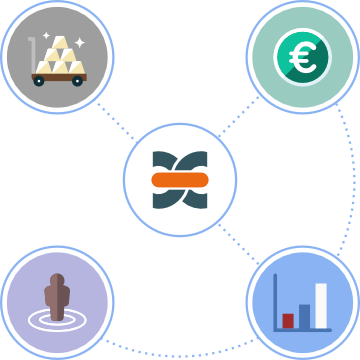Pegged Assets Exchange (PAX) - FAQ
- How are funds locked?
- Doesn’t this mean the coin supply increases?
- How are interest payments generated?
- So does locking funds mean that someone else has to take the other side of the trade?
- Why is this a big deal?
- Who might want to use this platform?
- How can I make money with this platform?
- What if I need to release my locked funds before the redeem date?
- Do I need collateral to peg funds?
- Can’t the price feeds be compromise to game or attack the system?
- Is the BitcoinDark platform approved under my jurisdiction’s regulatory framework?

How are funds locked?
Funds are locked against a security, currency or commodity by burning them. The burn transaction includes a message that records the real-world security for which they are being exchanged and for how long, plus the hash of a secret phrase that will be used to redeem the funds in the future (‘bearer bits’). Security prices are provided by a decentralised price feed. At the redeem date, new coins are created from the coinbase at the new value of the security as provided by the price feed.
Doesn’t this mean the coin supply increases?
No. To prevent the overall coin supply from rising above its pre-set limit, users are incentivised to take the opposing trade through variable interest rates. (For example, if one user exchanges BTCD for +gold, believing that gold will rise against BTCD, the rewards for locking -gold – the bet that gold will fall against BTCD – increase to counterbalance this.) There are limits to the availability to different securities if the system gets too far out of balance. For more information see our infographic.
How are interest payments generated?
Short-term traders pay fees on the spread, but do not receive any interest, which is applied monthly.
So does locking funds mean that someone else has to take the other side of the trade?
No – funds are locked and redeemed unilaterally. It is not a simple zero-sum trade.
Why is this a big deal?
No solution to date has managed to peg inherently volatile cryptocurrency to real-world assets in a fully decentralised way without requiring any collateral.
Who might want to use this platform?
- Gamblers who want to take bets on binary options, such as the price of gold going up or down in the immediate future.
- Short-term traders who want to lock funds overnight or at the weekend when they are not trading.
- Long-term traders who want to invest in securities or commodities over a timeframe of weeks or months.
How can I make money with this platform?
If you are a long-term investor, you can earn interest on locked funds (such as USD or gold) by taking a contrarian position when the market conditions are favourable. For example, if interest rates for +USD are 5%, this means that more people believe that USD will go down against BTCD. Investing in +USD means your funds will be pegged to USD, and you will be paid interest on the balance on redeem.
What if I need to release my locked funds before the redeem date?
Your funds will stay locked until the redeem block. You will ultimately be able to trade locked funds on InstantDEX, though you will have to accept market price, which may differ from the redeem price, with or without interest.
Do I need collateral to peg funds?
No. The only funds you require are the BTCD that will be locked to their corresponding value of the pegged asset at the time of conversion.
Can’t the price feeds be compromise to game or attack the system?
If you can reliably hack and alter enough of the different price feeds for an asset, without the providers noticing, changing the prices subtly enough for the smoothing algorithm not to filter them out, for long enough to make a significant different to the price, and at the randomised and unknown block time within the redeem window, then it is possible that you might be able to make a minimal different to the redeem price of locked funds.
Is the BitcoinDark platform approved under my jurisdiction’s regulatory framework?
We hope not, but this cannot be guaranteed. Please do your own research as the developers cannot be held responsible for any consequences arising from your use of this software.